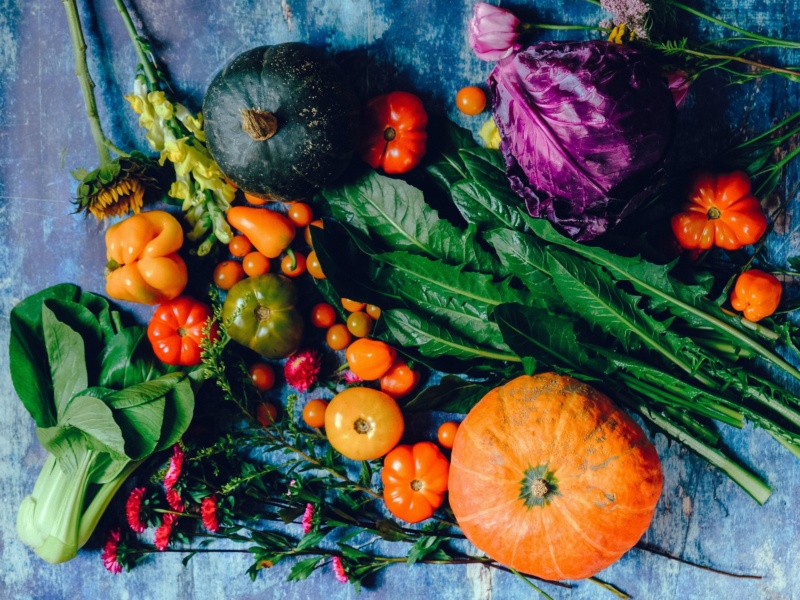Eating a rainbow sounds intuitively like it must be a fabulous thing. As it turns out, it is great for your health plus it tastes delicious! The different colour of fruit and vegetables is caused by different phytochemicals, which work to protect the plant from ultraviolet light, insects, germs, and other threats, but also end up working for our health too. Therefore food of the same colour tend to contain similar nutrients, minerals, vitamins and antioxidants which is why ‘eating a rainbow’ will give you a a variety of tastes and goodness to help you satisfied and healthy. Take a look at the culinary colours below and some of their health benefits.
-
Red
Vegetables: beetroots, radishes, red capsicums, red onions, rhubarb, tomatoes
Fruit: cherries, cranberries, guava, pink grapefruit, pomegranates, raspberries, red apples, red dragonfruit, red grapes, red pears, rose apple, strawberries, watermelon
Aromatics: chillies
Red fruit and vegetables contains the carotenoid lycopene and ellagic acid and quercetin, which tend to reduce the risk of diabetes, heart disease and improve skin quality.
Strawberries and beets are good sources of folic acid. Cranberries, strawberries, raspberries, pink grapefruit and red capsicum all are loaded with vitamin C. Red capsicums are an excellent source of vitamin A, which is necessary for eye and skin health. Cranberries, which contain a compound that prevents bacteria from sticking to the bladder walls, protect against urinary tract infections.
With most fruit and veggies, the more you cook them, the more nutrients get lost. That’s different, however, with tomatoes. Cooking actually increases their goodness. Lycopene is a great antioxidant found in tomatoes and is much higher in cooked tomatoes and sauces.
-
Green
Vegetables: artichoke hearts, asparagus, bok choy, broccoli, broccolini, brussel sprouts, cabbage, celery, chinese cabbage, choy sum, collard greens, cucumber, endaname, green beans, green capsicum, kailan, kale, leeks, lettuce, mizuna, okra, peas, rocket (arugula), snap peas, snowpeas, spinach, spring onions, watercress, zucchini.
Fruit: avocado, green apples, green grapes, honeydew melon, kiwifruit, limes, pears
Herbs: basil, chives, coriander, dill, garlic chives, kaffir lime leaves, parsley, pandan, rosemary, sage, thyme
We all know that greens are excellent healthy food! They get their green colour from the pigment chlorophyll which is good for the prevention of diseases. Two carotenoids, known as lutein and zeaxanthin, exist in natural green food and act as potent antioxidants. Leafy greens (such as rocket, spinach, kale, lettuces) are high in vitamin A and are a good source of calcium. Cruciferous vegetables, such as brussel sprouts and broccoli, are also high in vitamin A. Vitamin C is found in broccoli, cabbage, kiwi fruit and green capsicum. So, who said it wasn’t easy being green?!
-
Yellow and orange
Vegetables: butternut squash, carrots, corn, orange capsicums, pumpkins, sweet potatoes, yellow squash, yellow tomatoes, yellow zucchini
Fruit: apricots, calamansi limes, cape gooseberry, cloudberries, durian, grapefruit, jackfruit, kumquats, lemons, mandarins, mangoes, nectarines, oranges, papaya, passionfruit, peaches, persimmons, pineapples, pomelo, rockmelons, starfruit (carambola), tangerines
Yellow and orange fruit and vegetables often contain betacarotene, vitamin C, potassium, folic acid, lutei and bromelaine. Vitamin C, a strong anti-oxidant which strengthens your body’s natural defence and reduces high blood pressure, bad cholesterol and triglycerides, is found in carrots, mango, oranges, orange capsicum, peaches, nectarines, papaya and sweet potatoes. Pumpkin, sweet potatoes, and butternut squash are all high in potassium, which is great for lowering your blood pressure. For folic acid, eat carrots, corn, rock melon and yellow squash. Pineapple contains the bromelaine enzyme, which helps digestion and reduces infection and swelling. Citrus fruit contain the phytonutrient hesperidin, which helps to increase blood flow. Lutein is a caratenoid that is stored in the eye. It helps reduce cataracts and age-related macular degeneration, two of the most common causes of blindness. So, eat up all that yellow and orange goodness!
-
Blue and purple
Vegetables: eggplant, purple cabbage, radicchio lettuce
Fruit: blackberries, blackcurrants, blueberries, figs, plums, prunes, and raisins
Blue and purple food is loaded with the phytonutrients called anthocyanins, which are understood to decrease the risk of macular degeneration (of the eyes) and stroke.
Blueberries are loaded with vitamin C.
-
White
Vegetables: cauliflower, daikon radish, fennel, Jerusalem artichoke, jicama, lotus root, mushrooms, onions, parsnips, potatoes, taro, turnips, white beans (cannellini and navy)
Fruit: bananas, coconuts, custard apples, dates, dragonfruit, feijoa, langsat, longan, lychees, mangosteen, plantains, rambutans, salak, soursop, white peaches, white nectarines
Aromatics: garlic, galangal, ginger, lemongrass
Eating white fruit and vegetables reduces your risk of stroke. They contain the phytonutrients EGCG, allicin, isothiocyanate, quercetin and anthocyanidins, which provide healthy benefits for your arteries, bones and circulation. Mushrooms boost your immune system. Onions and garlic are rich in polyphenols, an anti-oxidant that controls chronic inflammation and can reduce the risk of Type 2 dementia, Alzheimer’s disease and heart disease. Onions also contain quercetin which eases arthritis symptoms and builds a strong immune system. White beans are rich in antixoxidants and lower bad cholesterol. Cauliflower contains sulphur chemicals that work to strengthen bones, reduce the risk of cancer, and help healthy blood vessels. So tuck into those white fruit and veggies!
So ultimately, eating a rainbow of fruit and vegetables does wonders for your health. You don’t have to eat them all in one meal. They’re also sure to make your plate and bowl look a lot more appetising! So go eat a rainbow now and gather the healthy pot of gold at the end. What will you put in your rainbow?
